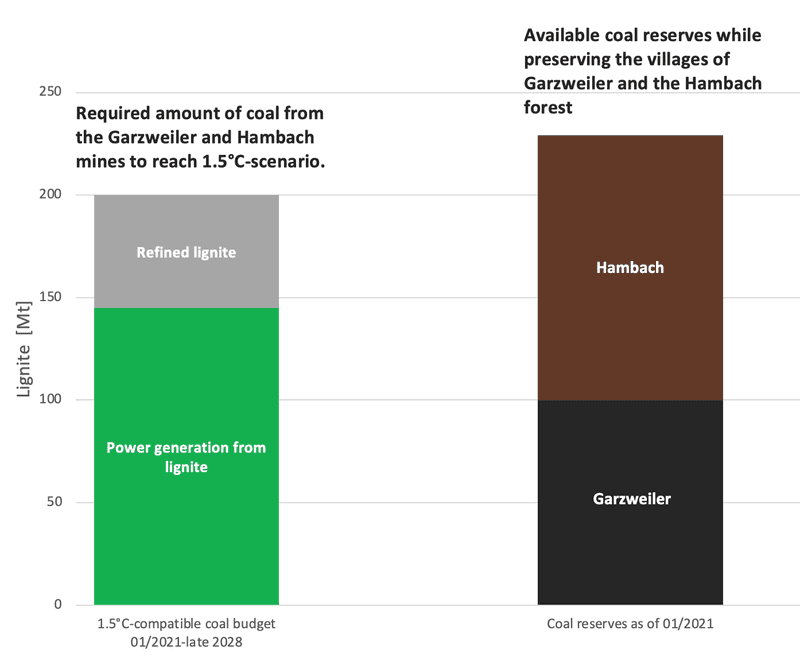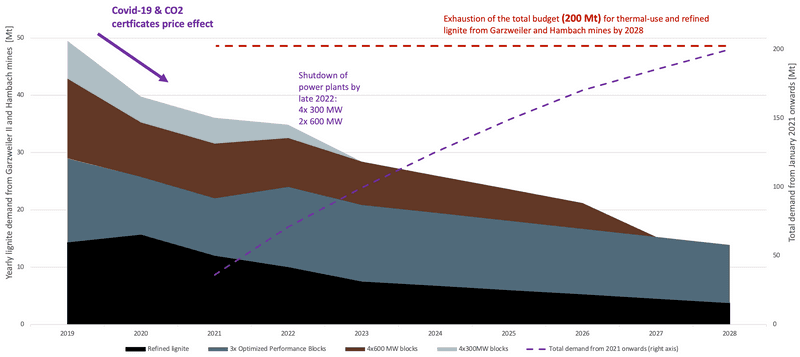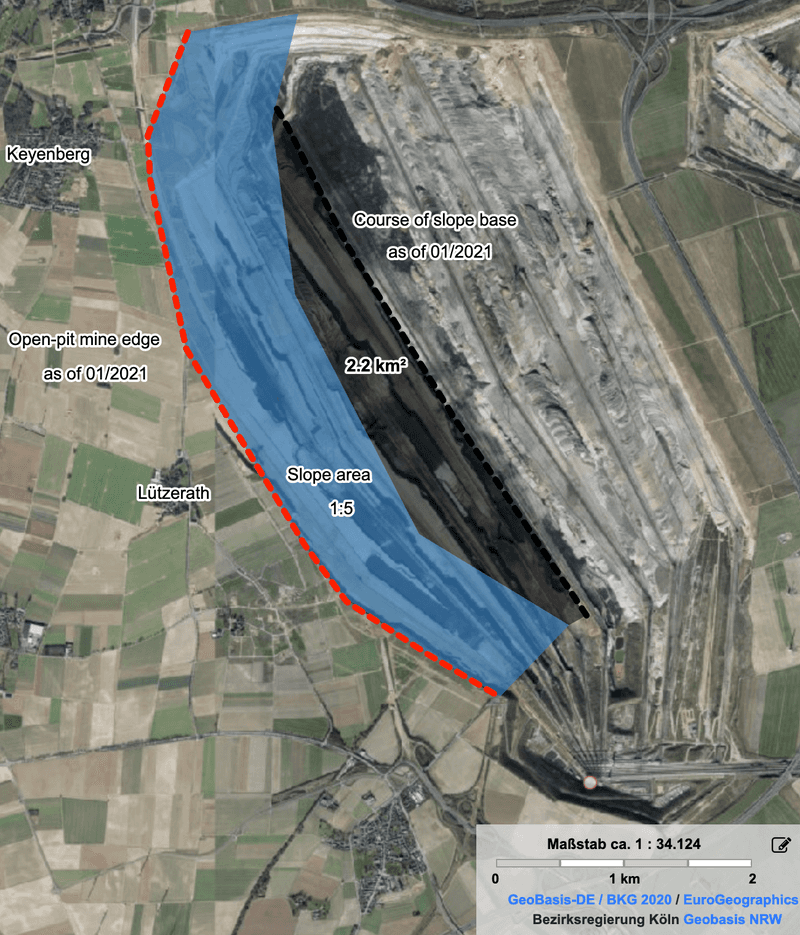29. November 2021Outdated realities, new challenges
Recalibrating open-pit lignite mining policies in North-Rhine Westphalia to a feasible 1.5-degree scenario. Germany must deal with significant policy challenges to reach its greenhouse gas emission commitments under the Paris Accord: One of them concerns the future of its large-scale lignite mines in the western region of North-Rhine Westphalia (NRW). A recent study by DIW Berlin reveals that the current policy and production plan of the opencast mine operator would result in Germany's CO2 budget for meeting the 1.5-degree limit being far exceeded. Thus, lignite mines and power plants in NRW will be required to significantly reduce their output. This recalibration according to the 1.5-degree scenario means abandoning current expansion plans, saving several villages from resettlement and leaving millions of tons of coal in the ground, and phasing out with reduced coal consumption as early as 2028.
Background, method, and goals of the study
The study follows an emissions-budget approach to calculate the maximum permissible amount of North-Rhine Westphalian lignite that can be extracted and burned under a 1.5-degree scenario. Next, we compared the constrained budget to current output schedules and expansion plans, as determined by the utility company RWE and the state government of NRW. From the analysis we were able to infer immediately implementable policy recommendations to 1) reach emissions targets while also 2) respecting the socio-economic and environmental impact of lignite mining in the region.
Calculating a CO2-budget for North-Rhine Westphalian lignite
According to the IPCC (2018), the remaining global CO2-budget for a 50 percent chance of limiting global warming to 1.5 degrees Celsius amounts to emissions of 580 Gigatons CO2.[1] In accordance with Germany’s current share of the world population, this would equate to a CO2-budget of 4.2 gigatons from 2020 onwards. Based on annual production, the calculations grant lignite mines in NRW a total CO2-budget of 180 million tons for power generation, with a 145 million of which allocated to the two mines of Garzweiler II and Hambach.[2] Hence, all power plants that are connected to the lignite mines will directly be affected by the mines’ pathway. A swift but gradual reduction in lignite mining thus requires an equal reduction in power generation from lignite. This budget is expanded to 200 million tons so as to account for the production of refined lignite for industrial processes.[3] One ton of lignite usually results in the emission of a ton of CO2.

Figure 1: Comparison of coal demand in the 1.5°C scenario with the reserves in the opencast mines Garzweiler II
and Hambach, own illustration
Recent developments and the future of lignite
In recent years, the state government of NRW and RWE Power AG have agreed on multiple strategies to gradually reduce the usage of lignite. So far, however, this has merely resulted in scaling down expansion plans or delaying decisions, but far not to CO2 emissions being reduced sufficiently to be back in line with the 1.5 degree target according to the Paris Climate Agreement.[4] The plans of the opencast mine operator and the state government ignore the fact that lignite’s share of total electricity generation has entered a steady path of decline, not least because of the global pandemic’s economic repercussions but mainly because of far pricier emissions certificates eating away at its cost competitiveness. Besides, lignite is facing ever tougher competition from flexible renewables and natural gas.[5]

Figure 2: Overview of coal stocks still needed from Garzweiler II and Hambach, own illustration
Key takeaways from the analysis
Considering recent developments, as well as a production budget constrained to 200 million tons of lignite, the only remaining question is: Where exactly the should the remaining production take place? Due to the tremendous environmental and social impact of these mines, this decision should not be entirely based on economic merit. Hambach’s lignite reserves amount to 130 million tons, while Garzweiler II boasts reserves of 650 million tons. Based on geographical analyses of lignite seams and satellite images, we were able to show that enough of the resource could be mined at both mines without further expanding the mines to currently populated or environmentally important territories (e.g., forests and nature reserves) so that in particular all villages threatened by resettlement can be preserved.[6]

Figure 3: Draft of a mining area adapted to the 1.5°C limit for the opencast mine Garzweiler II
with a reserve of around 100 million t of lignite, own dimensions based on (GeoBasis NRW 2020)
Conclusion
To conclude, the study has not only laid out a pathway to reconcile lignite mining with a 1.5-degree scenario, but also shown how adhering to this pathway could result in saving several communities and nature reserves from destruction. In any case, the complete exploitation of Garzweiler II and Hambach’s lignite reserves has proven incompatible with even having a 50 percent chance of reaching the 1.5-degrees target set out in the Paris Accord.
[1] Starting January 1st, 2018.
[2] Own calculations based on SRU 2020.
[3] Refined lignite does not form part of the electricity sector’s emissions budget but is nevertheless relevant for the lignite mining operations of the study.
[4] RWE Power AG 2020, NRW State Ministry of Economic Affairs 2021
[5] Fraunhofer ISE 2021a, 2021b and
[6] See maps and illustrations
Further Reading
Catharina Rieve, Philipp Herpich, Luna Brandes, Pao-Yu Oei, Claudia Kemfert und Christian von Hirschhausen (2021). Kein Grad weiter – Anpassung der Tagebauplanung im Rheinischen Braunkohlerevier zur Einhaltung der 1,5-Grad-Grenze. Deutsches Institut für Wirtschaftsforschung (DIW) Berlin. Available at: https://www.diw.de/documents/publikationen/73/diw_01.c.819609.de/diwkompakt_2021-169.pdf.
Work Cited
Fraunhofer ISE. 2021a. „Energy-Charts“. 2021. https://energy-charts.info/charts/energy/chart.htm?l=de&c=DE&year=-1&inter- val=year&source=all&download-format=image/jpeg.
Fraunhofer ISE. 2021b. „Nettostromerzeugung in Deutschland 2020: erneuerbare Energien erstmals über 50 Prozent“. Fraunhofer-Institut für Solare Energiesysteme ISE. 2021. https://www.ise.fraunhofer.de/de/presse-und-medien/news/2020/nettostromer- zeugung-in-deutschland-2021-erneuerbare-energien-erstmals-ueber-50-pro- zent.html.
IPCC. 2018. „Global warming of 1.5°C. An IPCC Special Report on the impacts of global warming of 1.5°C above pre-industrial levels and related global greenhouse gas emission path- ways, in the context of strengthening the global response to the threat of climate change, sustainable development, and efforts to eradicate poverty“. New York, NY, USA: IPCC. https://www.ipcc.ch/sr15/download/.
NRW Wirtschaftsministerium. 2021. „Leitentscheidung 2021“. https://www.wirt- schaft.nrw/pressemitteilung/landeskabinett-beschliesst-neue-leitentscheidung.
RWE Power AG. 2020. „Neues Revierkonzept“. 2020. https://www.group.rwe/unser-portfolio-leistun- gen/rohstoffe-energietraeger/braunkohle/neues-revierkonzept.
SRU. 2017. „Kohleausstieg jetzt einleiten“. Berlin: Sachverständigenrat für Umweltfragen.
SRU. 2020. „Umweltgutachten 2020 – Für eine entschlossene Umweltpolitik in Deutschland und Europa“. Berlin: Sachverständigenrat für Umweltfragen. https://www.umwelt- rat.de/SharedDocs/Downloads/DE/01_Umweltgutachten/2016_2020/2020_Umwelt- gutachten_Entschlossene_Umweltpolitik.pdf?__blob=publicationFile&v=18.
Authors
Catharina Rieve
Research Associate | CoalExit Group
Deutsches Institut für Wirtschaftsforschung Berlin | Technische Universität Berlin | Europa-Universität Flensburg
Nicolas Malz
Research Assistant | CoalExit Group
Technische Universität Berlin
Editor
Co-Head of Research Unit Global Climate Governance
Wuppertal Institute for Climate, Environment and Energy
Energy, Transport, and Climate Policy Division